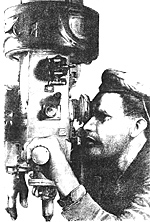
PETER HANSEN (251-LIFE-1987) spent time working for the ABWEHR (the German Secret Service) during WW II and he has information that is known to a mere handful of people. He gives this secret information especially to SHARKHUNTERS. Here he tells us:
In KTB #152 last month, we read of the transfer of U-511 to the I.J.N. which was renamed Ro-500. Here we learn what happened to one of the German Skippers serving in the Japanese ports. Because of eyesight problems, Dommes was ordered ashore and became the German Chief for the three Southeastern bases. His Executive Officer (I.W.O.) Kapitanleutnant Wilhelm Spahr became captain of U-178 instead. Spahr was the former Obersteuermann of Gunther Prien's U-47, except on that final patrol of course, who had been promoted to officer status (and off the boat).
Now the supply magicians really had to produce miracles, like European style foods, bread and canned goods - literally from scratch. Again the Chinamen came through with flying colors and overcame all occurring obstacles with their native slyness, just loving to outsmart the Japanese whom they hated.
EDITORS NOTE - Under Fritz Steinhoff, U-511 became the first submarine to fire rockets from underwater. His brother worked with Werner von Braun on the rocket project at Peenemunde and when they were ready to test fire some rockets from underwater, naturally his brother's U-boat was chosen. At the end of the war, Steinhoff surrendered in the USA and died in the Boston jail. Suicide was listed as the official cause of death, but someone in the cell next to his said it was murder. That will be covered when we look at the history of U-511.
U-511 became the Japanese submarine Ro-500 and the transfer operation was named `Cherry Blossom', showing that at least some people at the OKM in Berlin had some twisted sense of humor. For reasons of secrecy, the German U-boatmen had to be shaved immediately and were allowed only to get about in civilian clothing. One can imagine the delight of the sailors and stokers to wear civilian suits, hats and silk shirts again, not to speak of silken underwear even and clean socks and new shoes, framed with colorful neckties. The German crewmen were paid in Chinese dollars whilst in Southeast Asian bases, because the natives refused to accept Japanese occupation currency or German marks for that matter. But because Japanese authorities insisted these men had to put a small cocade on their lapels with a black and yellow design, this charade was immediately obvious to everybody and nobody mistook the U-boatmen for civilians anyhow even though the Japanese Navy thought they were the only people who would recognize the German crews.
The higher such ridiculous orders originate, the more unrealistic they usually are. With other words, things started to get rolling just after the North Atlantic had to be practically vacated by U-boats in the summer of 1943 and thereafter but of course, Type VII U-boats could not reach the Far East even with two or more refuelings generally. However, as there was a clear problem of not having a sufficient resupply of torpedoes available, the few at hand had largely been removed from various auxiliary cruisers and a few came aboard supply ships from Europe, operating as blockade runners to the Orient in reverse.
The torpedo supply U-boat Type VII-F was quickly designed to remedy this serious handicap. This was done by adding one full section to the hull, increasing the length accordingly and adding about 400 tons carrying capacity to this modified Type VII-F. They were built by the Krupp Germania yard in Kiel. Only four were constructed and they were:
- U-1059 commissioned 1 May `43 under command of Oblt Gunther Leopold, Class of 1938. It was sunk 19 March 1944 near the Cape Verde Isles by USS BLOCK ISLAND task force
U-1060 commissioned 15 March 1943 under command of Obit Herbert Brammer; sunk on 27 October 1944 in Trondheim fjord by RAF A/C from the carrier HMS IMPLACABLE.
U-1061 commissioned 25 August 1943 under command of Oblt Heinz Gerhardt Jager; given over to the Allies at Bergen at the end of the war;
U-1062 commissioned 19 June 1943 under command of Oblt Karl Albrecht, Class of 1938, sailed from Christiansand on 3 January 1944 and reached Penang 19 April 1944 with a load of 39 torpedoes. On her homeward voyage however, she was sunk on 30 September 1944 by the destroyer USS FESSENDEN.
Back to KTB # 153 Table of Contents
Back to KTB List of Issues
Back to MagWeb Master Magazine List
© Copyright 2001 by Harry Cooper, Sharkhunters International, Inc.
This article appears in MagWeb.com (Magazine Web) on the Internet World Wide Web. Other articles from military history and related magazines are available at http://www.magweb.com
Join Sharkhunters International, Inc.: PO Box 1539, Hernando, FL 34442, ph: 352-637-2917, fax: 352-637-6289, www.sharkhunters.com
